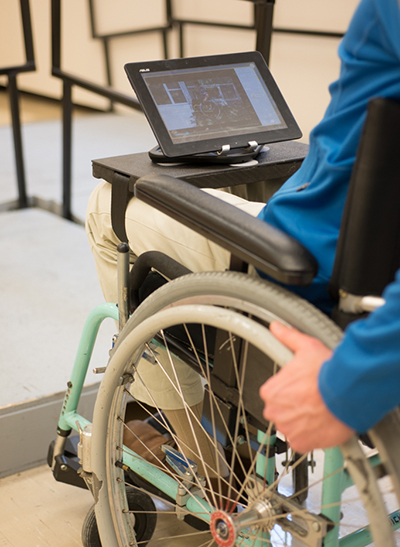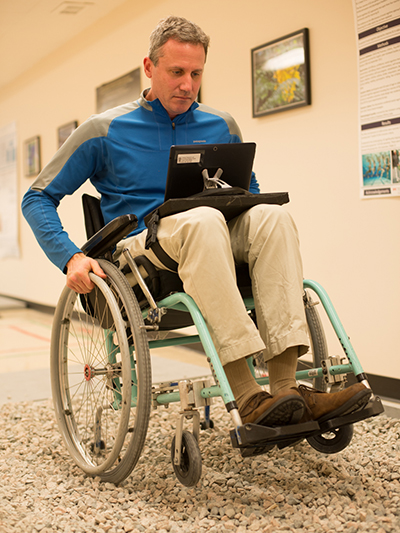Two UBC-led trials test ways to help wheelchair users make the most of their devices.
By Brian Kladko
Communications Manager, Faculty of Medicine
The platform in front of me was only 15 centimetres high. But it might as well have been a 10-metre wall in an army training obstacle course: I was seated in a wheelchair.
Unlike most of the people who use this basement room in G.F. Strong Rehabilitation Centre, I could have easily stood up and stepped over it if I chose. But I wanted to appreciate the challenges posed to anyone who didn’t have that choice.
To help me overcome those challenges, I was heeding the advice of EPICWheels, an application running on an electronic tablet on a small tray strapped to my lap.
EPICWheels is an experiment – at least for now – unfolding in B.C. and Manitoba, to determine whether a computer-based tutorial can improve the wheelchair handling skills of older adults.
Searching for a cost-effective solution
EPICWheels is one of two randomized controlled trials led by Bill Miller, Professor in the Department of Occupational Science and Occupational Therapy, about the efficacy of wheelchair training. The other, called WheelSeeU, is examining the impact of a training program led by older adults experienced in wheelchair use. The peer-trainer meets two learners (also 55 or older) in six, two-hour sessions, in Vancouver and Quebec City.
Both programs are designed to impart skills more cost-effectively than the gold-standard of individualized training with professional therapists. EPICWheels (Enhancing Participation in the Community by improving Wheelchair Skills), is low-cost and convenient for users, since it can be done at home. WheelSeeU (Wheelchair Self-efficacy enhanced for Use) is more costly, more complicated, and involves more effort by participants, but provides individualized goal-setting and customized task-specific practice.
But either program, in theory, would be a huge improvement over the current situation for most older adults who are prescribed a wheelchair. People who have broken a hip, or are suffering from progressive osteoarthritis, or have not fully recovered from a stroke rarely get the gold-standard treatment. Usually, they receive little or no instruction beyond transferring from the chair to the bed, toilet or car.
“There’s a stereotyping going on – ‘They’re just going to get pushed around by their caregiver, so why waste the resources?’” says Dr. Miller, whose father spent most of his adult life in a wheelchair after contracting polio. “They are also victims of our low expectations – just because they may not be able to go up and down stairs, we write them off.”
Propelling, turning, ascending and descending
Compounding that stereotype, there may also be a lack of appreciation for wheelchair mobility skills, which don’t come naturally.
It begins with proper ergonomics. After two years in a chair, shoulder joint pain and deconditioning is common, so users must learn how hard to push efficiently and how to relax.
“People push more often than they need to, and they just don’t realize it,” said Ed Giesbrecht, a PhD student in Rehabilitation Sciences, and one of the EPICWheels co-investigators.
Turning isn’t difficult, but there are ways to do it better, such as making turns tighter (for navigating smaller spaces) or turning without slowing down (by sliding one’s hand along a wall). Keeping a wheelchair straight on a side-sloping sidewalk can be frustrating without proper technique.
Then there are obstacles. Ramps are great, but it takes some strength to go up (leaning forward is key) and going down can be dangerous. And, of course, there are elevation changes – doorways, an elevator that doesn’t line up with a floor, even stairs – that are best overcome by popping a wheelie. (Yes, wheelies are not just for showing off.)
“Time your pop”
In the Wheelchair Skills Testing Room at G.F. Strong, the EPICWheels tutorial led me through that technique with images, video and a pleasant narrator. With that newly acquired knowledge, I attempted going over a short ledge, then traversed several metres of gravel – the crunching sound was disconcerting, but I got through it.I then tried the 15-centimeter ledge.
“Dude, you’re not even close to getting over,” the photographer documenting my trial helpfully observed.
Fortunately for my ego, a ledge that high is considered advanced (and isn’t even covered by the tutorial).
“You’ve got to race at it, time your pop, then, once your casters land, you’ve got to lean forward and offload to get the back wheels up,” Giesbrecht told me later.
Both studies, which began last year, are meant to test the feasibility of larger, multi-site trials, while also collecting preliminary results about the actual impact on wheelchair users. Dr. Miller, who is affiliated with Vancouver Coastal Health Research Institute, hopes the studies demonstrate an impact, because too many wheelchair users are socially isolated or overly dependent on caregivers, due to a lack of skills or confidence in using the device.
“If the belief in the ability to learn these skills is there, the more likely the behaviour will happen,” he says. “We must find a way, with limited resources, to instill that belief.”
The EPICWheels and WheelSeeU studies are both seeking research participants. To learn more, contact Kate Keetch, 604-714-4108, kate.keetch@vch.ca.


